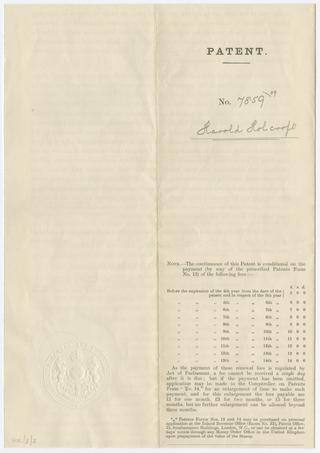
Holcroft, Harold 1882 - 1973
- Nationality:
- British
Harold Holcroft, was a railway engineer, born in Wolverhampton on the 12th of February 1882. His interest in railways, especially in locomotives, began at an early age. This was in part thanks to the inspiration of family friend Joe Armstrong, son of Joseph Armstrong, who would visit when Holcroft was growing up. At the time, Armstrong was the assistant to the Chief Locomotive Engineer at the Great Western Railway (GWR). As a result, Holcroft developed a strong fondness for the Great Western and the Stafford Road works in particular. In 1898, when Holcroft was 16, he chose to undertake a five year apprenticeship there. At the age of 18, he designed a system to improve the efficiency of continuous brakes on engines used for freight and shunting work, drawing the attention of his superiors at GWR. Once his apprenticeship finished in 1903, he was transferred to the Drawing Office where he aided in designing locomotives and plans for extensions and improvements of the works.
Following this, Holcroft moved to the Swindon Drawing Office in 1906, where he assisted in the design of George Churchward’s locomotives, and improvements to the Swindon works. Part of his work here involved improving the attractiveness of Churchward’s designs, which had been criticized by some. Holcroft made aesthetic changes to some locomotives, which were applied to a large number of GWR locomotives (the National Railway Museum’s own GWR 4003 “Lode Star” features some of these elements). It was also during his time here that Holcroft designed and patented his conjugated valve gear for three-cylinder locomotives. In July 1909, he took a trip to Canada and the United States with a group of engineers to see various works and engineering projects. This visit inspired him, especially the many 2-6-0 “Mogul” arrangement locomotives he saw, which inspired the GWR 4300 Class locomotives.
As it became clear that Churchward had no further plans for new locomotive designs in the near future, Holcroft began to seek out a new opportunity. In 1914, he moved on to the South Eastern and Chatham Railway, where Richard Maunsell required someone to execute plans for extending and reorganising the locomotive, carriage, and wagon shops at Ashford. However, the war quickly postponed these plans. Soon after joining the railway, Holcroft suffered a bout of illness, during which time he further worked on his conjugated valve. In 1919, Nigel Gresley requested to meet Holcroft to discuss their ideas regarding three-cylinder locomotives. Following their collaboration, Gresley incorporated the ideas into his three-cylinder designs. Gresley inquired as to the possibility of hiring Holcroft, but Maunsell refused to allow it.
Following the “grouping” of the railways in 1923, Holcroft moved to Maunsell’s new office as Chief Mechanical Engineer at Southern Railway. Holcroft set about dealing with the issues presented by the grouping; for example, the various railways and locomotives now amalgamated together were not necessarily compatible, and Holcroft was tasked with ascertaining where locomotives would or would not be able to run. Not long after, in 1926, Holcroft became Chief Assistant to Maunsell. He continued to work on issues such as standardizing parts within the new Southern Railway, improving sheds and depots, and a wide array of other tasks. Of course, his favourite work was still undertaking trials on the footplate of locomotives. In the 1930s, he took part in a number of trials relating to steam conservation technology.
When Maunsell retired in 1937, Oliver Bulleid took over his role. Holcroft remained, but the more hands-on approach of the new chief meant Holcroft had less responsibility over the aspects of his role he most cherished. Holcroft and Bulleid became good friends, and after Holcroft’s retirement in 1946 they remained in touch until the latter’s death. Following Holcroft’s retirement from the Southern Railway, he wrote a number of books, journal articles and papers. He continued to write until the age of 90, when he finished a manuscript for his final book, although it was never published. He died on the 15th of February 1973.

